Easy Ways to Align Vinyl Siding at Corners
While vinyl siding isn't for everyone, millions of American homeowners have decided it's just the thing for them. And if we could reduce the substantial cost of vinyl siding installation, legions of others would surely follow suit. According to HomeAdvisor, the average vinyl siding installation cost is $11,136, and most homeowners pay between $6,070 and $16,405 for an entire house.
Luckily, you can cut that hefty price tag by nearly 50 percent—if you're willing to do the work yourself. Most home centers sell vinyl siding, and the materials come with fairly complete instructions. Plus, the tool requirements are also pretty modest.
➡ You love DIY projects. So do we. Let's build something cool together.
While vinyl can be a great alternative to regular house paint (and it does a good job of dressing up problem walls), there is a tradeoff. Although it looks like conventional siding from a distance, the illusion falters at corners, windows, doors and wall-mounted utility equipment.
Part of the design dilemma is that vinyl expands and contracts a good deal with changes in temperature. A standard 12-foot length can be 1/2 to 5/8 inches shorter on a very cold day as compared to a very hot day. For this reason, vinyl must be cut short and nailed loose. In fact, you should be able to slide every full-length side-to-side by at least 1/2 inch after it's installed. The trim pieces made to conceal the ends accommodate these variations quite well, but not without some compromise in appearance.
➡️ Vinyl Siding Installation: Materials and Tools
While you can expect differences among manufacturers, siding systems generally include 12-foot lengths of siding, window/door trim channel, J-channel, utility channel, corner moldings, and metal starter strips. In addition, vented and unvented soffits, as well as fascia covers, are available.
The siding must be installed over a flat surface, so unless you're siding a new home, or have removed the old lap siding, you'll need to line the wall with sheets of rigid-foam board, usually 1/2-inch thick. While rigid foam offers some insulation, its primary function is to provide a flat nailing surface. Both the rigid foam and siding can be nailed in place with galvanized shingle nails.
Vinyl siding comes in several styles and in a variety of colors. We chose a Dutch lap style, which has the look of tongue-and-groove car siding, because of its distinctive profile.
All vinyl siding and vinyl soffit and fascia can be cut with tin snips, a circular saw with a plywood blade, or by scoring it with a knife and breaking it.
➡️ Vinyl Siding Installation Step #1: Soffit and Fascia
Starting with the soffit, nail lengths of J-channel against the inner edge of the fascia board. This channel conceals the cut edges of the soffit lengths as they meet the fascia. All siding and soffit pieces have nail slots. Nail at the slot centers to allow for expansion and hold the heads out 1/32 to 1/16 inch. Don't nail anything tight.
If your home has a box soffit or a hip roof, nail a second band of J-channel along the soffit edge as it meets the house. If your home does not have a boxed soffit return, but has soffit plywood nailed to the bottoms of the ceiling joists, you may be able to omit the inner channel. In this case, the ends of the soffit lengths can be concealed later by the utility trim of the siding. The angle of the soffit makes the difference here, but when in doubt, it's best to channel both edges.
➡️ Vinyl Siding Installation Step #2: Soffit and Fascia
If the soffit on your home wraps around a corner, as with a hip roof, you'll need to make some provisions for the soffit material's change in direction at the corners. To accommodate this change, nail two J-channels diagonally between the corner of the house and the corner of the roof. Then, cut the first soffit sections to fit this angle and install subsequent sections in both directions. Where existing soffit vents are located, remove the vents and install vented soffit material.
➡️ Vinyl Siding Installation Step #3: Soffit and Fascia
Because the soffit pieces come in 12-foot lengths, you'll need to custom-cut each piece to fit the span. With the diagonal corner pieces installed, cut the remaining lengths of soffit material 1/4-inch short of the maximum span, and press them into the channel. Either bend the soffit pieces to fit, or carefully pry the channel back to gain the needed access.
➡️ Vinyl Siding Installation Step #4: Soffit and Fascia
With the soffit installed, remove the gutter and slide preformed lengths of fascia cover under the gutter apron. Carefully nail the upper portion of the fascia with 4D galvanized or pre-painted nails. But don't overdo it. A nail every few feet will do. When joining fascia pieces in the corners, run slightly past the original eave fascia, and butt the intersecting gable fascia against this overrun. Finally, replace the gutter.
While this fascia installation works for many homes, complicated or decorative trim is best left to a professional who can custom-make and fit aluminum components.
➡️ Vinyl Siding Installation Step #5: Siding the Walls
Begin by loosening or taking off all easily removable obstacles, such as porch lights, address plates, handrails, and self-storing clothesline reels.
Then, measure from the eave to the bottom of the existing siding. If this distance is divisible by 8 inches—the finished width of a piece of siding—you're in luck. The utility trim you'll install under the eave will accept the top edge of the last full-width row of siding. In the case of Dutch lap siding, which looks like two courses of siding in each single panel, you'll have two opportunities: at 4- and 8-inch intervals.
If raising or lowering the starter edge an inch or two will make the top pieces fall where you want them, by all means, do so. If you have to cut the top row of siding, then use J-channel at the top instead of utility trim. To keep this last cut row from collapsing against the house, nail a 3-inch strip of 1/2-inch plywood against the J-channel to hold it out.
When you've determined the best height for the metal starter strip, mark this position on the walls and snap a reference chalkline around the entire house. Then, nail a 3 1/2-inch strip of 1/2-inch plywood above this line to hold out the bottom of the first row of siding, and nail the starter strip to this plywood.
➡️ Vinyl Siding Installation Step #6: Siding the Walls
Next, nail strips of 1/2-inch rigid-foam sheathing to both sides of the corners and nail the corner trim over these strips.
➡️ Vinyl Siding Installation Step #7: Siding the Walls
Follow by nailing window and door trim around any exterior doors and sheath the first few feet of the walls with insulation. This will leave you ready to install siding on the lower portion of the first wall. Measure for the first piece and trim it to length, making sure that it's 1/2-inch shorter than the distance between vertical trimpieces, as measured from the inside surfaces of the channels.
➡️ Vinyl Siding Installation Step #8: Siding the Walls
Snap each length of siding in place, so that its bottom lip hooks under the starter strip. Slide it into the corner and nail it every 16 inches or so. Be sure to center the nails in their slots to accommodate expansion.
➡️ Vinyl Siding Installation Step #9: Siding the Walls
When joining two lengths of siding, lap one length over the other approximately 1 inch. As for which direction to lap, consider which angle will get the closer scrutiny. If the walk leading to the front door approaches from the left, a left-over-right lap will be less conspicuous.
➡️ Vinyl Siding Installation Step #10: Dealing with Obstructions
If your home has a deck, it's likely to be suspended from a wall and covering the bottom of the existing siding. In this case, you'll need to maintain the starter-strip height on both sides of the deck and trim the siding to fit above the deck.
Begin by installing the first row of siding on both sides of the deck. To provide a common reference point, measure up 8 inches from the top of this row and stretch a string line across the deck. Then, trim around the door leading onto the deck. Door and window trim that is about 1 1/4-inches deep will accommodate 1/2-inch insulation board as well as the 1/2-inch siding. Finally, measure the distance from the first row to the deck top and cut the siding to fit over the deck.
To secure this trimmed length, nail J-channel along the top of the deck, backed by a strip of 1/2-inch plywood.
➡️ Vinyl Siding Installation Step #11: Dealing with Obstructions
You may use rigid-foam backing, but plywood makes a stronger support. Install the siding adjacent to the deck conventionally, and press the cut section into the J-channel.
➡️ Vinyl Siding Installation Step #12: Dealing with Obstructions
To side under a faucet, remove the two mounting screws and pull the faucet out from the wall. If yours won't pull out, check to see if you can shift the pipe that feeds it.
Behind the faucet mounting plate, install 1/2-inch plywood in place of insulation board. Then, notch the siding from the top and slide it under the faucet. If the faucet falls in the center of the siding, create a lap joint and slide the notched lengths under the faucet from the sides.
➡️ Vinyl Siding Installation Step #13: Dealing with Obstructions
As for permanent utility equipment, you'll simply have to work around it. In the case of an external conduit, nail insulation backing board around it and trim the sides and top with J-channel. Cut a top cap to meet the flanges of the vertical pieces. Then, snip the bottom of the channel 1/2 inch on each side and bend these tabs down to create a drip edge. Nail the cap over the vertical pieces.
➡️ Vinyl Siding Installation Step #14: Dealing with Obstructions
Finally, caulk the J-channel where it meets the conduit.
➡️ Vinyl Siding Installation Step #15: Window and Door Trim
When you reach a window or door, cut away any caulk that might keep the new trim from laying flat against the existing molding. At windows, cut trim channel to match the length of the sill and then nail it into place.
Cut two lengths of channel for the sides, allowing an extra 2 inches on each. At the bottom, make a 1-inch cut along the corner of the facing edge. Bend the wide surface of the channel inward at this cut to make a drip-edge tab and slide the tab under the sill channel. At the top of a window or door, cut off all but the face of the trim flush with the existing top molding, and nail the trim in place.
➡️ Vinyl Siding Installation Step #16: Window and Door Trim
Finally, cut the top channel 2 inches longer than the window or door width and use the excess to create drip edges. This time, however, cut off the back of the channel flush and let the facing edge run long. Set the channel in place, secure it, and trim the excess from the facing edges.
➡️ Vinyl Siding Installation Step #17: Window and Door Trim
With the insulation backing in place, install siding to within one row of the bottom of the window. Then, notch the next piece to fit. To stiffen the trimmed section, slide a length of utility trim over it.
➡️ Vinyl Siding Installation Step #18: Window and Door Trim
Finally, slide the siding in place from below and nail it.
➡️ Vinyl Siding Installation Step #19: Window and Door Trim
Install siding at the top of a window or door in a similar fashion, but this time set the siding on the window channel and use the window trim to mark the cut.
➡️ Vinyl Siding Installation Step #20: Meet the Soffit
When the siding is within a foot of completion, nail lengths of utility trim to the wall just below the soffit.
➡️ Vinyl Siding Installation Step #21: Meet the Soffit
Then, nail the second-to-last row in place, and measure the width of the last piece. Use a utility knife to score the siding lengthwise, and break the siding along this line.
➡️ Vinyl Siding Installation Step # 22: Meet the Soffit
The simplest way to secure the last piece is to nail the top with 3D painted nails—colored to match your siding. While this method works, it allows for little expansion. If you opt for this method, nail sparingly—about one nail every six to eight feet.
A more professional approach requires a crimping tool that fastens aluminum clips to the top edge of the siding, while still allowing lateral movement. Place the clips every 12 to 16 inches.
➡️ Vinyl Siding Installation Step #23: Meet the Soffit
With the siding clipped and ready, push it into the utility channel until both the top and bottom of the siding engage with a reassuring click. To finish gable ends, trim the gables with J-channel, cut each length of siding to match the slope of the roof, and nail the siding in place. Finally, caulk all trim where it meets doors, windows and utilities.
🎥 Now Watch This:
This content is created and maintained by a third party, and imported onto this page to help users provide their email addresses. You may be able to find more information about this and similar content at piano.io
Source: https://www.popularmechanics.com/home/how-to-plans/how-to/a169/installing-vinyl-siding-easily/
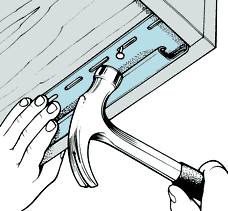
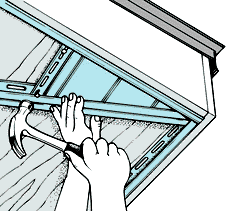

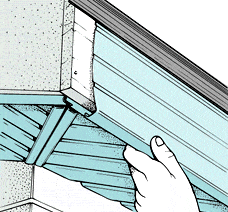
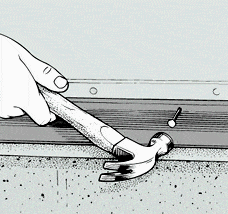
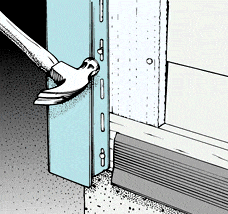
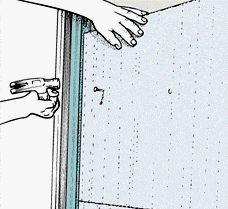

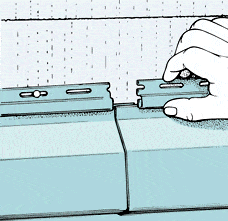

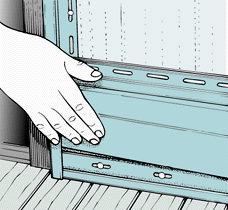

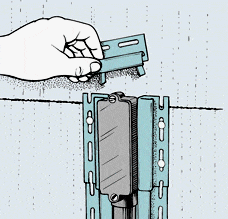
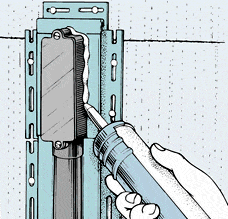

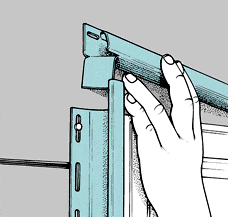
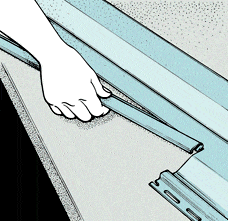


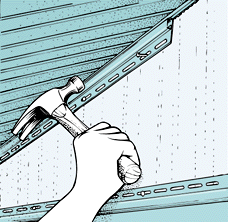



0 Response to "Easy Ways to Align Vinyl Siding at Corners"
Post a Comment